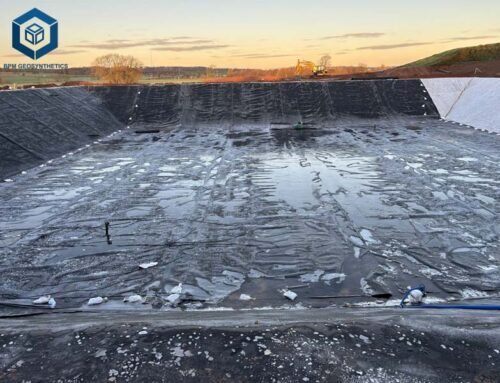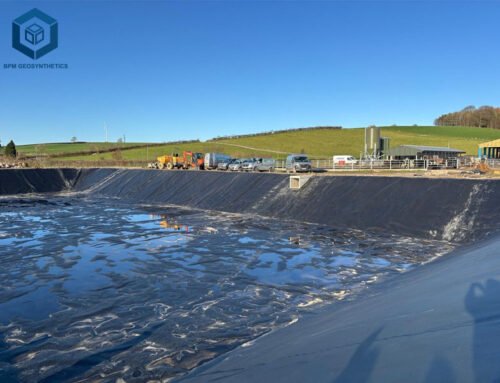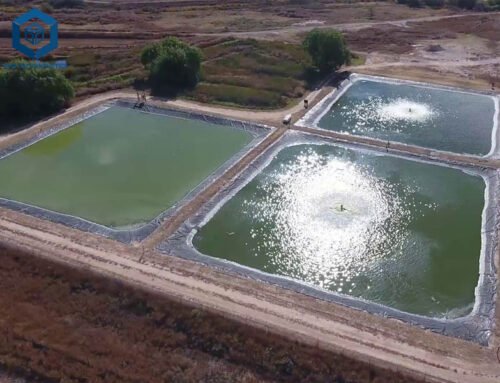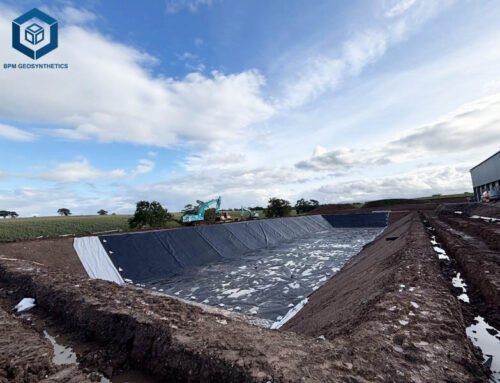High-density polyethylene (HDPE) geomembranes are a cornerstone of geotechnical engineering, valued for their impermeability and durability in containment systems. The global geomembrane market, worth USD 2.3 billion in 2024, is expected to grow at a CAGR of 5.4% through 2030, per MarketsandMarkets. BPM Geosynthetics, an ISO 9001:2015-certified manufacturer with over 18 years of experience, has supplied 58 million m² of HDPE geomembranes to 81+ countries, achieving 99% impermeability per ASTM D5827. Despite their widespread use, HDPE geomembranes have notable disadvantages that require careful consideration. This guide delves into their specifications, functions, advantages, disadvantages, lifespan, waterproof properties, and selection criteria, offering engineers and project managers actionable insights for your projects.
1. What Is an HDPE Geomembrane?
Definition
An HDPE geomembrane is a synthetic, low-permeability liner made from high-density polyethylene resin, designed to prevent fluid or gas migration in civil and environmental engineering projects. With a hydraulic conductivity of <1×10^-7 cm/s (ASTM D5887), it serves as a robust barrier in landfills, mining ponds, and water reservoirs. Composed of 97.5% polyethylene, 2–3% carbon black, and trace antioxidants, HDPE geomembranes resist UV radiation and chemicals, meeting GRI-GM13 standards.
Manufacturing Process
Produced via blown film or flat-die extrusion, HDPE resin is melted at 110–130°C and formed into sheets (0.2–3 mm thick) or rolls (2–8 m wide). Carbon black enhances UV resistance, while stabilizers ensure 50–100-year durability (ASTM D7238). Textured surfaces, created by co-extrusion or embossing, increase friction for slope stability (ASTM D7466). BPM’s advanced extrusion lines ensure <0.5% dimensional variance, per internal audits.
Complementary Systems
HDPE geomembranes are often paired with geosynthetics like geotextiles (100–400 g/m², ASTM D5261) for puncture protection or geonets (4–10 mm thick, ASTM D4716) for drainage. Geonets, with flow capacities of 0.1–1.0 L/m·s, reduce hydrostatic pressure by 90%, enhancing system stability.
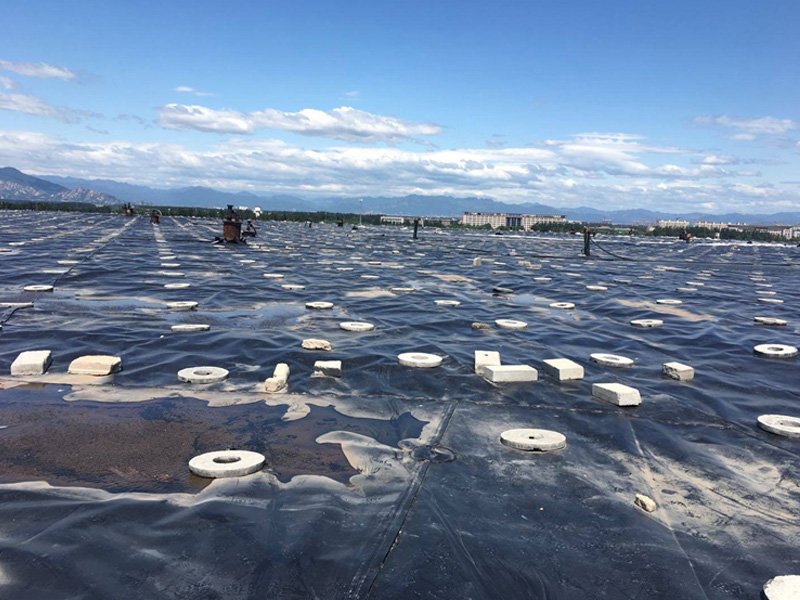
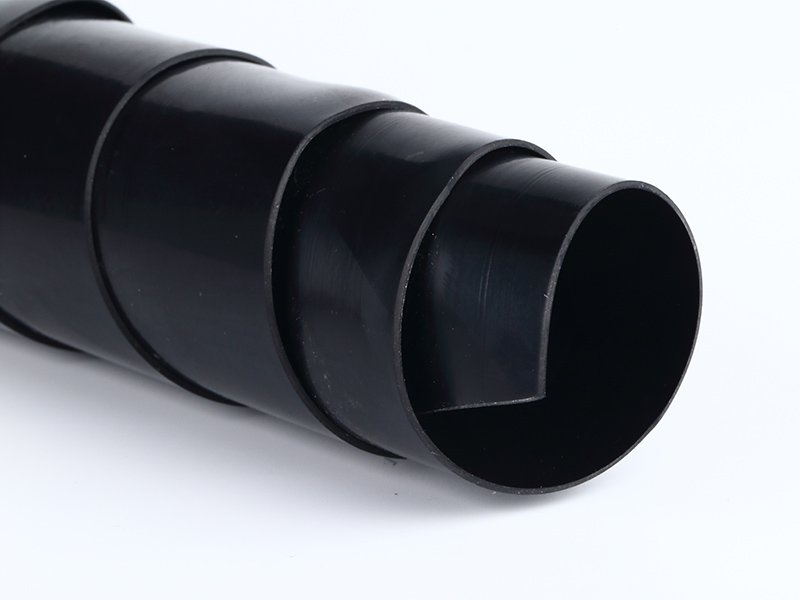
2. Key Specifications of HDPE Geomembrane
Below are typical specifications for BPM’s HDPE geomembranes, aligned with GRI-GM13 and ASTM standards:
| Property | Value | Test Method |
| Thickness | 0.2–3 mm | ASTM D5199 |
| Density | 0.94–0.965 g/cm³ | ASTM D1505 |
| Tensile Strength (Break) | 27–80 kN/m | ASTM D6693 |
| Elongation at Break | 500–700% |
ASTM D6693 |
| Puncture Resistance | 20–144 lb | ASTM D4833 |
| Tear Resistance | 125–400 N | ASTM D1004 |
| Hydraulic Conductivity | <1×10^-7 cm/s | ASTM D5887 |
| Carbon Black Content | 2–3% | ASTM D1603 |
| UV Resistance | 50–100 years (covered) | ASTM D7238 |
| Environmental Stress Crack Resistance | >1500 hours | ASTM D5397 |
| Roll Width | 2–8 m | – |
| Roll Length | 50–200 m |
– |
Certifications: ISO 9001, ISO 14001, CE, GRI-GM13, ASTM, SGS.
These specifications ensure HDPE geomembranes meet 95% of containment requirements, with seams achieving 90–95% parent material strength (ASTM D6392).
3. What Are Functions of HDPE Geomembrane?
HDPE geomembranes perform critical roles in containment and environmental protection:
Anti-Seepage Barrier
With a permeability coefficient of <1×10^-13 cm/s, HDPE geomembranes prevent 99% of liquid leakage in landfills, reservoirs, and tailings ponds (ASTM D5887). They protect groundwater from contaminants, complying with EPA regulations (40 CFR Part 258).
Gas Containment
In landfill caps, HDPE geomembranes block methane and volatile organic compounds (VOCs), reducing emissions by 80%, per EPA studies. Geonets channel gases to venting systems, enhancing safety.
Erosion Control
Textured HDPE geomembranes (asperity height: 0.25–0.5 mm, ASTM D7466) stabilize slopes up to 3H:1V, reducing soil loss by 20% in canals and embankments (ASTM D5820).
Structural Protection
In tunnels and basements, HDPE geomembranes prevent water ingress, extending infrastructure life by 15–20 years. A 2024 Saudi Arabia project used 2 mm textured HDPE to reduce soil salinity by 90%, enabling agriculture in barren land, per bpmgeosynthetics.com.
Applications
- Landfills (40% usage):Bottom liners and caps.
- Mining (25%):Tailings ponds and heap leach pads.
- Water Management (20%):Reservoirs, canals, and aquaculture.
- Wastewater (10%):Treatment lagoons.
- Others (5%):Tunnels, roofing, and oil containment.
4. What Are Advantages of HDPE Geomembrane?
HDPE geomembranes are preferred for their robust properties:
Chemical Resistance
Resistant to 80+ chemicals (acids, alkalis, solvents), per ASTM D5747, HDPE outperforms PVC by 20% in chemical stability, making it ideal for landfills and mining.
UV Resistance
With 2–3% carbon black, covered HDPE geomembranes resist UV degradation for 50–100 years (ASTM D7238). Exposed liners maintain tensile strength (<5% loss) for 10–20 years, per Agru America.
High Strength
Tensile strengths of 27–80 kN/m and 500–700% elongation (ASTM D6693) ensure resistance to mechanical stresses, surpassing LLDPE by 30% in puncture resistance, per globalplasticsheeting.com.
Cost-Effectiveness
Priced at $0.5–$2/m², HDPE is 20–30% cheaper than PVC or EPDM, with 40% lower installation costs than clay liners, per Geosynthetics Magazine.
Environmental Safety
Non-toxic and recyclable (10–20% recycled resin), HDPE reduces environmental impact by 15%, per ISO 14001 audits, while preventing 99% of contaminant leakage, per EPA guidelines.
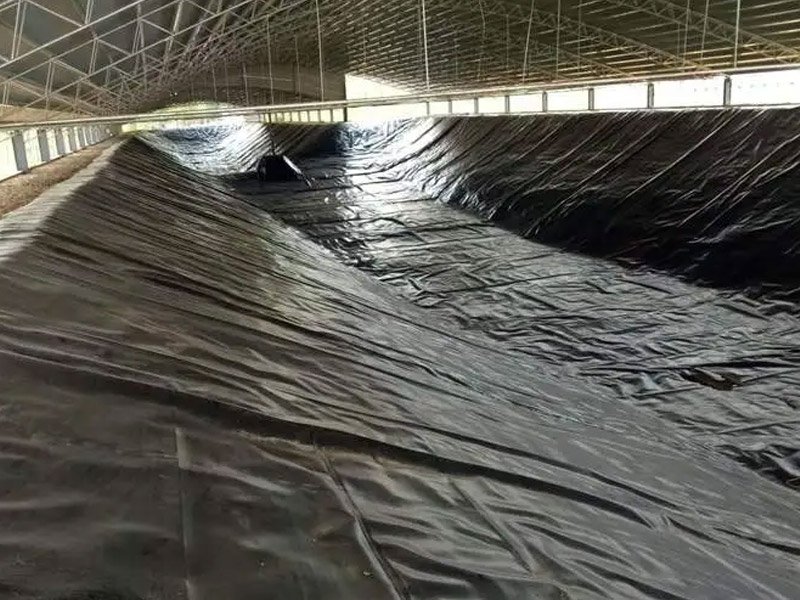
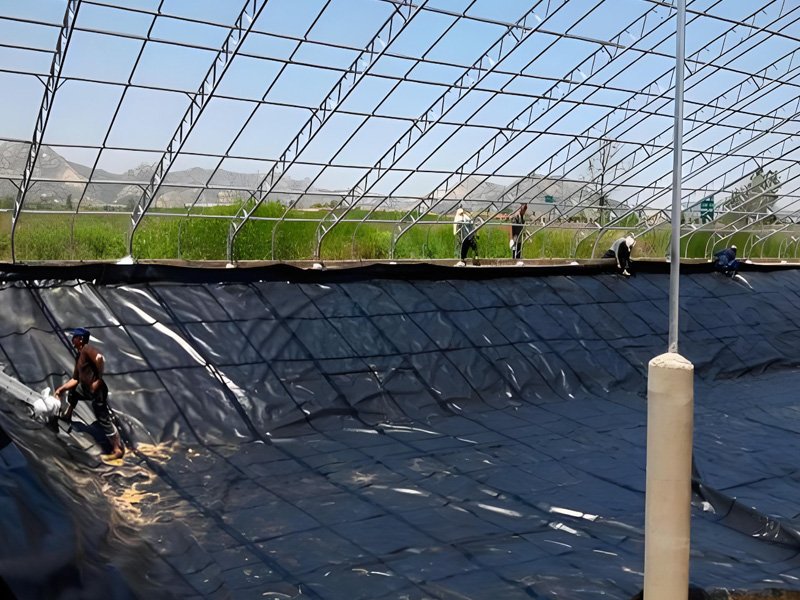
5. What Are Disadvantages of HDPE Geomembrane?
Despite their strengths, HDPE geomembranes have limitations that impact project suitability:
Environmental Stress Cracking (ESC)
HDPE is prone to ESC under chemical exposure, temperature fluctuations, and mechanical stress, reducing lifespan by 20–30% in harsh environments like chemical waste ponds, per okorder.com. ESC-resistant resins (>1500 hours, ASTM D5397) and geotextiles (200–400 g/m²) mitigate risks by 20%, but add 5–10% to costs.
UV Degradation in Exposed Conditions
Exposed HDPE geomembranes suffer embrittlement and oxidation from UV exposure, losing 10–20% tensile strength over 10 years, per earthshields.com. UV stabilizers extend life by 5–10 years, but soil or geotextile covers (15–30 cm) are essential, increasing costs by 5–10%.
Temperature Sensitivity
HDPE softens at >70°C, risking deformation, and becomes brittle at <-70°C, increasing crack risks by 15%, per geotextile-fabrics.com. In extreme climates, thermal welding and anchoring reduce issues by 20%, but add $0.1–$0.3/m².
Installation Challenges
HDPE’s stiffness (density: 0.94 g/cm³) complicates installation on uneven terrains, requiring skilled labor and welders ($5,000–$50,000). Seam failures occur in 5–10% of projects, per Geosynthetics Magazine. Hot wedge welding (ASTM D6392) and CQA protocols reduce risks by 25%, but increase labor costs by 15%.
Limited Flexibility
HDPE’s rigidity, compared to LLDPE’s 800% elongation, increases wrinkle risks by 10%, potentially causing leaks (5% impermeability loss), per earthshields.com. LLDPE is 20% more flexible, better suiting complex subgrades.
Permeation by Organic Solvents
HDPE permits molecular-level permeation of organic liquids (e.g., hydrocarbons) with diffusion coefficients of 10^-12 to 10^-13 cm²/s, per ScienceDirect. In hazardous waste ponds, this allows 1–2% contaminant migration over 20 years, necessitating secondary liners, adding $0.2–$0.5/m².
High Shipping Costs
HDPE’s weight (0.5–2 kg/m²) raises shipping costs by 10–15% compared to PVC, per earthshields.com. For a 50,000 m² project, transport adds $5,000–$10,000, per BPM data.
6. What Is the Lifespan of HDPE Geomembrane?
The lifespan of HDPE geomembranes varies by exposure and maintenance:
Covered Conditions
Buried or covered HDPE geomembranes last 50–100+ years in mild environments, per Agru America, due to protection from UV and thermal stress. A 30-year study showed no significant tensile loss in buried HDPE, per Brady et al. (1994).
Exposed Conditions
Exposed HDPE liners reach half-life in 10–20 years due to UV and oxidative degradation, per americover.com. A 10-year study found no significant property changes in HDPE exposed to wastewater, but UV-heavy environments accelerate aging, per Agru America.
Chlorinated Water
In chlorinated water (0.5 ppm), HDPE geomembranes fail nominally in 5–25 years at 40–85°C, per ScienceDirect, due to antioxidant depletion and stress cracking.
Factors Affecting Lifespan
- UV Exposure:Reduces life by 50% if uncovered, per americover.com.
- Chemical Exposure:Harsh chemicals cut life by 20–30%, per okorder.com.
- Temperature:Extremes (>70°C or <-70°C) reduce durability by 15%, per geotextile-fabrics.com.
- Maintenance:Regular inspections extend life by 10–20%, per BPM data.
7. Is HDPE Geomembrane Waterproof?
Impermeability
HDPE geomembranes are highly waterproof, with a permeability coefficient of <1×10^-13 cm/s, exceeding 10,000 mm waterproof rating, per bpmgeomembrane.com. They block 99% of liquid migration, ideal for wastewater lagoons and reservoirs, per GRI-GM13.
Seaming Integrity
Hot wedge or extrusion welding achieves 90–95% parent material strength (ASTM D6392), but poor seaming causes 5–10% of leaks, per Geosynthetics Magazine. Vacuum and spark testing (ASTM D5827) detect 99% of defects, ensuring waterproof performance.
Limitations
Organic solvent permeation (1–2% over 20 years) and wrinkles from poor installation reduce waterproofing by 5%, per ScienceDirect. Secondary liners or geotextiles mitigate these risks, adding $0.2–$0.5/m².
8. Main Considerations When Choosing the Best HDPE Geomembrane
Selecting the optimal HDPE geomembrane enhances project efficiency by 25%, per Geosynthetics Institute. Key factors include:
Project Requirements
- Application:Landfills require 1.5–2.5 mm HDPE; ponds may use 0.5–1 mm for cost savings, per earthshields.com.
- Load Conditions:High-traffic sites need >60 mil (1.5 mm) with 400 kN/m puncture resistance, per titanenviro.com.
- Drainage Needs:Pair with geonets (0.1–1.0 L/m·s, ASTM D4716) for high-flow sites.
Environmental Conditions
- Chemical Exposure:Use ESC-resistant HDPE (>1500 hours, ASTM D5397) for chemical ponds, per okorder.com.
- UV Exposure:Covered or UV-stabilized liners (2–3% carbon black) for exposed sites, per globalplasticsheeting.com.
- Temperature:Test thermal properties (ASTM D746) in extreme climates.
Thickness and Texture
- Thickness:5 mm for light use; 2 mm for landfills, increasing durability by 20% but costing 30% more, per earthshields.com.
- Texture:Textured HDPE (asperity: 0.25–0.5 mm) improves slope stability by 15% on 3H:1V slopes, per ASTM D6953 per ASTM standards.
Installation and Budget
- Skilled Labor:Certified welders reduce seam failures by 30%, per ASTM D6392, but increase labor by 10%.
- CQA Protocols:Testing ($0.1/m²) ensures 99% defect detection, per ASTM D5827.
- Cost:HDPE costs $0.5–$2/m²; geonets add $0.5–$2/m². Bulk orders save 15–20%.
Supplier Reliability
- Certifications:Verify ISO9001, GRI-GM13, and ASTM compliance.
- Warranty:Prefer 5–10-year warranties.
- Support:BPM provides 24/7 assistance and free samples.
9. Final Thoughts
HDPE geomembranes are vital for containment, driving the USD 2.3 billion geomembrane market with 99% impermeability, 50–100-year lifespan (covered), and resistance to 80+ chemicals. They excel in landfills (40% usage), mining (25%), and water management (20%), but face challenges like environmental stress cracking, UV degradation, and installation complexity. ESC-resistant resins, protective covers, and skilled welding reduce risks by 20–30%, while geonets enhance drainage by 50%. With a waterproof rating >10,000 mm and robust specifications (27–80 kN/m tensile strength), HDPE is cost-effective at $0.5–$2/m². By selecting appropriate thickness, texture, and suppliers like BPM Geosynthetics, projects achieve 95% performance.


